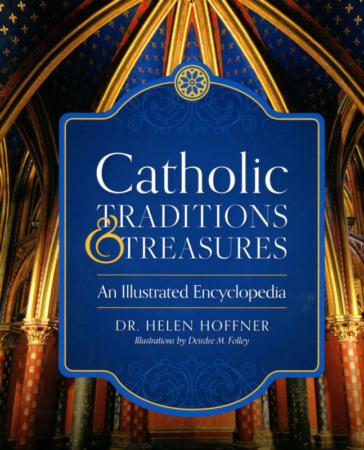Books
Books on Catholic customs, although beautiful, fall short on history
By Kathleen Finley
Posted: 6/7/2019


This is the cover of "Catholic Traditions and Treasures: An Illustrated Encyclopedia" by Dr. Helen Hoffner. The book is reviewed by Kathleen Finley. (CNS)
"Catholic Traditions and Treasures: An Illustrated Encyclopedia" by Dr. Helen Hoffner. Sophia Institute Press (Manchester, New Hampshire, 2018). 109 pp., $19.95.
"Celebrating a Merry Catholic Christmas: A Guide to the Customs and Feast Days of Advent and Christmas" by Father William Saunders. Tan Books (Charlotte, North Carolina, 2018). 173 pp., $27.95.
More than most Christian traditions and perhaps many other religious backgrounds, Catholics are people of the senses, with smells and bells and plenty of colorful and unique traditions. It's helpful to have guides to help us remember and share these in the midst of a culture that sometimes seems to have an attention span of 15 minutes, if we're lucky.
The challenge in sharing the traditions of the Catholic faith is to do it in a way that both helps clarify the essentials of our faith and shows how and why some other practices -- sometimes called sacramentals -- have emerged and continued. Unfortunately, these two books are not as reliable at that task as we might wish, and each has significant limitations, although both are beautifully published volumes.
In her book "Catholic Traditions and Treasures," Helen Hoffner has given the reader a somewhat skewed sense of the church, perhaps because of her background and credentials. She is a reading and language educational specialist and so may have had little formal training in what is central and what is less essential when it comes to Catholic life.
For example, her first chapter on the church includes the hierarchy, the Vatican and religious orders but includes nothing at all about the laity, who are key members of the church. Her discussion of sacraments is generally accurate but is occasionally simplistic ("The baptismal certificate is the passport to all things Catholic") or oddly pietistic (the custom of a lasso rosary at a Catholic wedding).
While Hoffner has many interesting and even unusual private devotions to mention here -- including medals, crucifixes, scapulars and Marian titles -- she only mentions the Mass under private Catholic devotions. One possible use for this book would be as a reference about some rather arcane Catholic trivia; however, without an alphabetical index that isn't really possible, either.
Father William Saunders, in his book "Celebrating A Merry Catholic Christmas," focuses on the rich Advent and Christmas seasons and has some helpful ideas about how to celebrate these seasons. However, his information on the historical origins of various traditions is at times incomplete and reliant on legend rather than historical scholarship.
For example, when discussing the Advent wreath he misses an ecumenical opportunity by not explaining that its origins were among German Lutherans in the 16th century and later developed there in the 19th century before being adopted by Catholic churches and homes only in the 20th century. When discussing St. Nicholas he neglects to mention how helpful the tradition of children setting out their shoes on the eve of his feast, Dec. 6, can be for little ones facing the long wait till Christmas itself.
When discussing the carol "The Twelve Days of Christmas" he relies on pious legends rather than factual information from historians and experts about the origin of the song. And his account of the beginnings of the Christmas tree, strikingly similar to the account mentioned in Catholic Answers.com, is not actually historical but rather from legend.
Although the origins of some of these traditions are lost in the mists of time, it is important where possible that we use the best historical scholarship rather than settling for pious legend in order to help cultivate a mature, adult faith.
When Father Saunders discusses the actual date of Christmas, he insists on the historical accuracy of the date of Dec. 25, although almost all modern scholars would disagree. However, the actual date doesn't really matter, since it has been our tradition since the mid-fourth century; however, he neglects to mention that before that time the key Christian holidays celebrated were Epiphany and Easter.
Although there is a strong need for the kind of resources these books intend to be, both at times fall short of what is needed, settling for pious legend and trivia instead of solid scholarship and a clear and full sense of what the rich Catholic tradition has to offer us.
- - -
Finley is the author of several books on practical spirituality, including "Our Family Book of Days: A Record Through the Years" and "The Liturgy of Motherhood: Moments of Grace," and previously taught in the religious studies department of Gonzaga University.